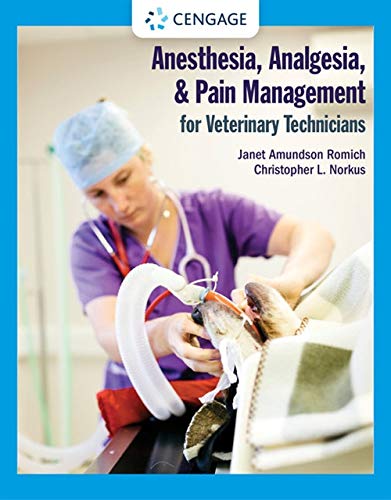Solution Manual for Anesthesia, Analgesia, and Pain Management for Veterinary Technicians, 1st Edition Janet Amundson Romich
$55.00
- Publisher : Cengage Learning; 1st edition (May 4, 2021)
- Language : English
- ISBN-10 : 1285737407
- ISBN-13 : 978-1285737409
You will receive this product within 24 hours after placing the order
Solution Manual for Anesthesia, Analgesia, and Pain Management for Veterinary Technicians, 1st Edition Janet Amundson Romich
Solution and Answer Guide
Romich, Anesthesia, Analgesia, and Pain Management 2022, ISBN 9781285737409;
Chapter 1: Introduction to Anesthesia
Table of Contents
Review Questions Multiple Choice Answers 1
Case Study Solutions 4
Case 1-1 4
Critical Thinking Questions Solutions 4
Review Questions Multiple Choice Answers
What is the correct definition of the term sedation?
- A drug-induced reversible state of unconsciousness and loss of sensation
- The state characterized by CNS depression accompanied by sleepiness/drowsiness and some degree of relaxation
- A drug-induced state of calm in which anxiety is relieved the patient is relaxed but remains aware of surroundings
- The loss of sensation in a discrete area of the body caused by the administration of a local anesthetic agent
Answer: b
What is the correct definition of the term tranquilization?
- A drug-induced reversible sate of unconsciousness and loss of sensation
- A drug-induced CNS depression and drowsiness in which the patient is generally unaware of surroundings but will respond to painful stimuli
- The administration of any of a group of compounds that calm and relax an anxious patient but do not induce sleep
- The loss of sensation in a discrete area of the body caused by the administration of a local anesthetic agent
Answer: c
What do the letters ACVAA stand for?
- American Congress for Veterinary Anesthesia and Analgesia
- Association Certification in Veterinary Anesthesia and Analgesia
- American College of Veterinary Anesthesia and Analgesia
- American Congress for Veterinary Analgesia and Anesthesia
Answer: c
The Academy of Veterinary Technicians in Anesthesia petitioned which veterinary technician organization in 1998 for recognition as the certifying body for veterinary technician specialists in anesthesia?
- Veterinary Support Personnel Network
- National Association of Veterinary Technicians in America-Committee on Veterinary Technician Specialties
- VetMedTeam-Anesthesia Technicians
- Veterinary Anaesthesia School for Technicians
Answer: b
Which two organizations write anesthesia guidelines?
-
- AVMA and AAHA
- AVMA and NAVTA
- IVAPM and ACVAA
- IVECCS and IVAPM
Answer: a
The job of working in veterinary anesthesia entails
- monitoring and recovering the anesthesia patient, caring for all anesthetic equipment, and administering certain medications.
- preparing and monitoring surgical patients, autoclaving surgical equipment, and discharging patients after they recover from anesthesia.
- monitoring and recovering the anesthesia patient, deciding which medications to administer, and preparing surgical summary reports.
- deciding which medications to administer, recording vital signs of the patient while under anesthesia, and disinfecting surgical equipment.
Answer: a
Why is it important to have anesthetic equipment calibrated regularly?
- Without calibration there is no guarantee that everyone has been properly trained in the use of anesthesia equipment.
- Without calibration the equipment will require extensive repairs the next time it is serviced.
- Without calibration unqualified veterinary staff may manually alter the anesthetic level.
- Without calibration the equipment may give incorrect readings and/or operate incorrectly.
Answer: d
What does ASA stand for?
- Anesthetic Society of Anesthetists
- Association for Safe Anesthesia
- American Society of Anesthesiologists
- Anesthesia Safety for Animals
Answer: c
What does balanced anesthesia mean?
- Anesthetic drugs are weighed on a scale before being administered to the patient because many drugs are administered during the anesthetic event
- General anesthesia produced by administering several drugs with the goal of utilizing each drug’s positive actions while avoiding potential adverse effects associated with large doses of a single drug
- Anesthesia produced by introducing anesthetic agent into the rectum in an attempt to use varying administration routes
- General inhalation anesthesia in which there is no rebreathing of the expired gases
Answer: b
What does the term analgesia mean?
- Relief of pain without loss of consciousness; absence of pain or noxious stimulation
- Injection of an agent into the spinal canal, generally either into the subarachnoid or epidural space
- A substance used for the control of excessive reaction to or overdosing with a narcotic
- The combining of pain-relieving agents that act on different mechanisms of nociceptive modulation to enhance additive and synergistic effects
Answer: a
To perform ocular procedures, such as corneal foreign body removal, proparacaine drops are applied to desensitize the cornea. Which type of anesthesia does this describe?
- Regional
- Surgical
- Local
- Dissociative
Answer: c
By which routes is general anesthesia most commonly administered?
- Intravenously, intramuscularly, and subcutaneously
- Intravenously, subcutaneously, and intraperitoneally
- Inhalation, intramuscularly, and intraperitoneally
- Inhalation, intravenously, and intramuscularly
Answer: d
A dog is given anesthetic agents and becomes unconscious and does not have any pain perception. Which type of anesthesia does this describe?
- Dissociative
- General
- Regional
- Local
Answer: b


Reviews
There are no reviews yet.